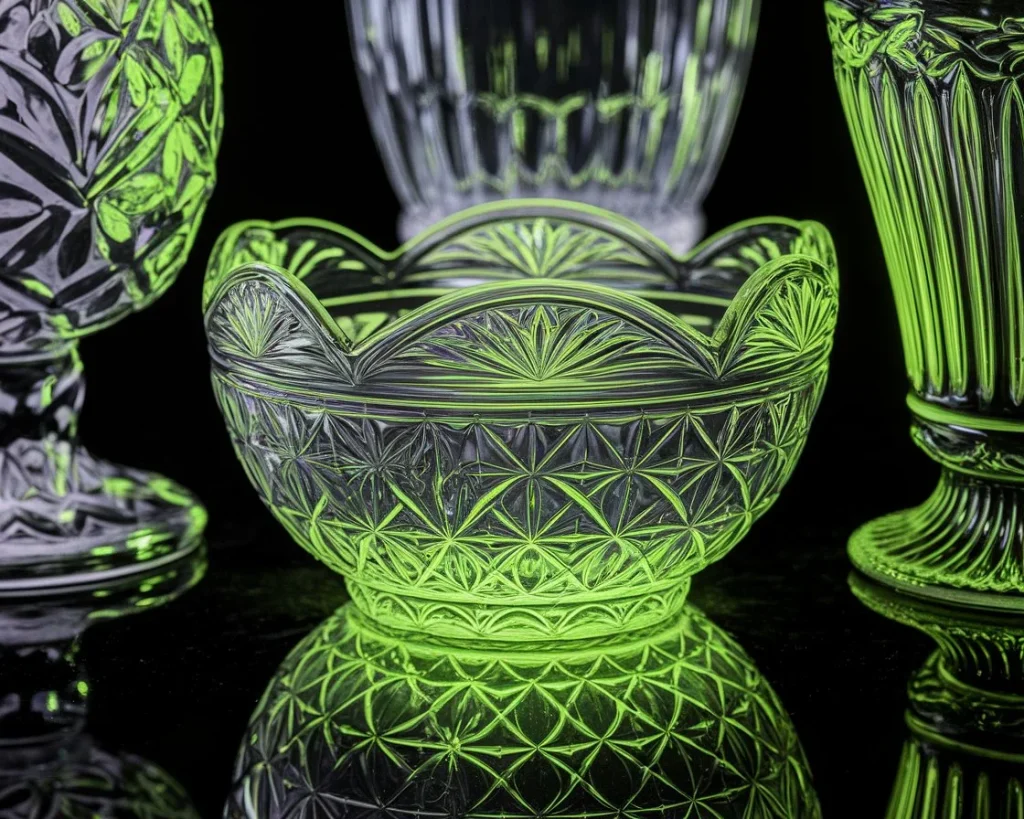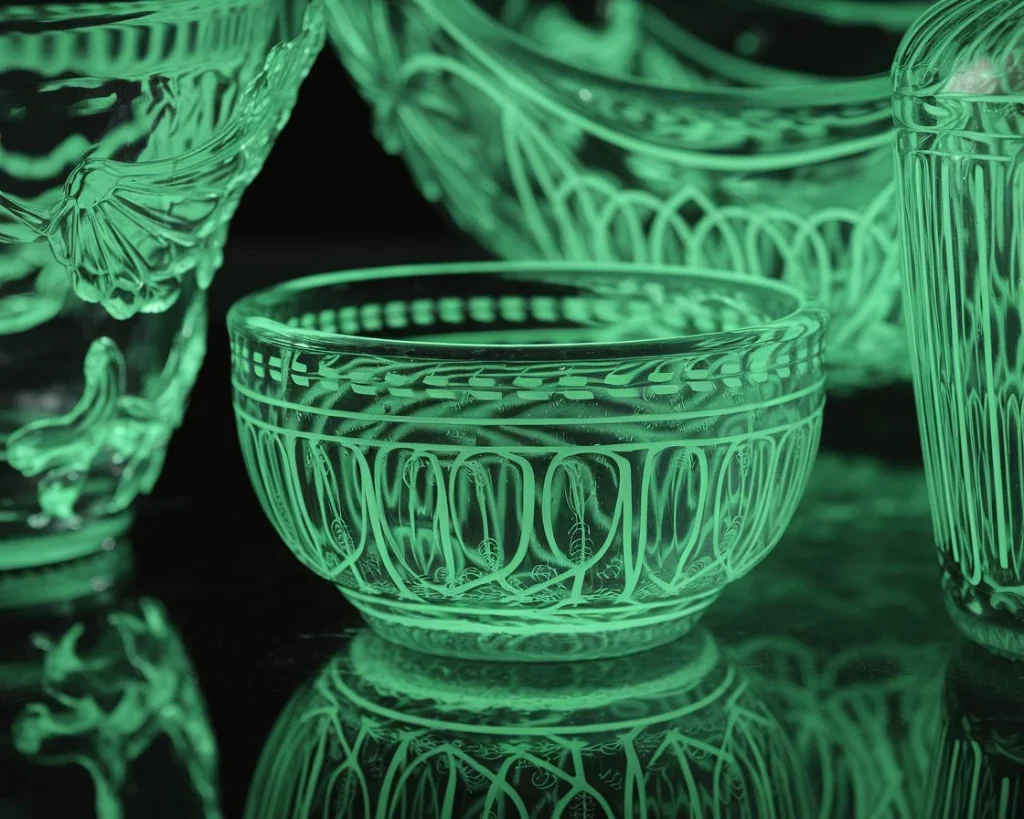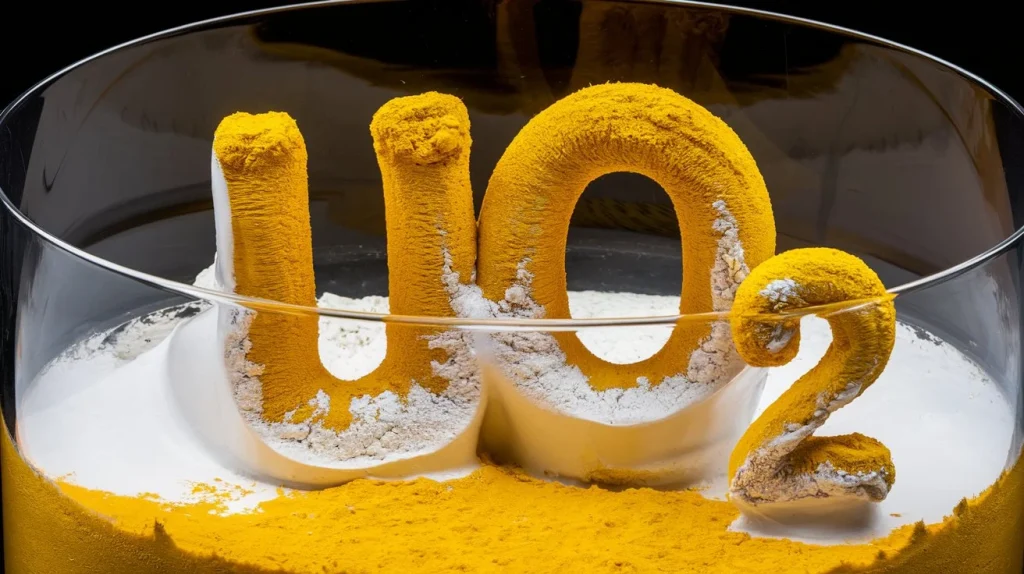Welcome to the Facinating world of Uranium glass
Discover the captivating story of uranium glass—a luminous relic of history. Learn about its origins, value, and the safety of owning these mesmerizing artifacts.
Have you ever seen any piece of glass that glows mysteriously under UV light?
Suppose you are holding an ordinary piece of glassware, perhaps a delicate green bowl, an elegant yellow goblet, or a small object like beads or marbles. It looks gorgeous in daylight. But then, at night, it comes alive and becomes fluorescent.
Welcome to the beautiful world of Uranium glass! This unique antique luminous glass, is known for their vibrant and captivating Green or yellow color that glows under UV light. Form the past centuries, this beautiful Uranium glass has been the center of attraction for antique lovers.
From its ancient origin to its use as art in glassware Uranium glasses hold a rich history.
What Is Uranium Glass?
Uranium glass is a type of glass that contains Uranium typically in the form of uranium oxide (UO₂), which is added to glass before melting to create a fluorescent effect and color. The proportion usually varies from trace amount to about 2% by weight, although some 20th-century pieces were made with up to 25% uranium (Huge!)
Uranium glass is used for decorative, tableware, or household items, with many pieces resembling carnival glass. Uranium glass bowls are particularly popular nowadays for their elegant, mysterious, fluorescent color.


We find some examples of uranium discovery from ancient historical civilizations, such as the following.
Holding a uranium glass means experiencing a unique blend of history, science, and artistry. This glass has been admired and collected for its distinctive beauty and unusual radioactive properties for centuries.
History of Uranium Glass
A German chemist Martin Heinrich Klaproth discovered Uranium in 1789. While analyzing the mineral pitchblende (now known as uraninite), Klaproth identified a new element, which he named uranium after the recently discovered planet Uranus.
Many scientists tried to use the fluorescent effect of Uranium to make various decorative stuffs and Uranium Glass is one of them. The uranium element is incorporated into the glasses as its salt form, (UO₂).

James Powell’s Whitefriars Glass, a company in London, first launched the Uranium glass items into the market. In a very short time, it became so popular that other companies also started manufacturing Uranium Glasses.
Uranium glasses were mainly used to manufacture various table items and decorative items, but during the ‘Cold War’ the use of Uranium was curtailed for most industries from the 1940s to 1990s. So the production of Uranium glasses was sharply reduced and the widespread use of these glasses also Restricted.
Origin of uranium glass
If we look at Ancient usage We find examples of uranium discovery from ancient historical civilizations, such as the following
Ancient Origin: Early use of uranium glass dates back to around 79 AD. In 1912, a mosaic containing yellow glass with 1% uranium oxide was discovered in a Roman villa on Cape Posillipo, located in the Bay of Naples, Italy.
Medieval Origin: Beginning in the late Middle Ages, pitchblende was mined from the Habsburg silver mines in Joachimsthal, Bohemia, and was used as a coloring agent in the local glassmaking industry.
How do you identify uranium glass?
It is a common question that comes across everyone’s mind, as per my expertise I am sharing basic ways to identify Uranium glass glasses or items.
Identification By color – First of all, look for the color, Uranium glass usually has a yellow-green tint. Some pieces might look more yellow, while others are more green, depending on how much uranium was used.
Check for a Smooth Finish – Uranium glass is often a well-made finish, with smooth edges and a shiny corner finish. Older pieces might show signs of wear but will still have their glow.
Feel the Weight – Slightly heavier than regular glass because of its composition.
The very easiest way to check if uranium glass is real is to keep it under UV light. The real uranium glass will be so dramatic that it will glow bright green under it. Uranium glass sometimes shows a soft green glow in bright sunlight. The fluorescent glow depends on the uranium content, but if glass glows under UV, it is unmistakably uranium glass.
Different types of uranium glass
Uranium glass exists in various types, each featuring its distinct colors and styles. Here are some of the most common ones:
- Vaseline Glass – It has transparent yellow-to-yellow-green glass that owes its color to its uranium content.
- Canary Glass – Canary glass is bright yellow, often with a hint of green.
- Green Uranium Glass – This type is a rich green color.
- Clear Uranium Glass -Some uranium glass looks almost clear but still has a slight green or yellow tint.
- Opaque Uranium Glass – It has shiny and clear versions, this type is cloudy or milk-like.
- Custard glass – Opaque or semiopaque pale yellow.
- Jadite glass – Opaque or semi-opaque pale green; initially, the name was trademarked as “Jadite”.
- Depression glass – Transparent or semitransparent pale green.
- Burmese glass – Opaque glass that shades from pink to yellow.
- Colored Uranium Glass – Uranium can be mixed with other materials to make pink, blue, or other colors.
- Carnival Uranium Glass – This type has a shiny, rainbow-like coating on the surface, often found in vintage or antique designs.
Is Vaseline Glass The Same As Uranium Glass?
Uranium glass content is typically in the purest form of uranium oxide diuranate to give it a special color and make it glow under ultraviolet (UV) light. Uranium glass can come in different colors, like green, yellow, or even clear.
Vaseline glass is a type of uranium glass, but it is not the same. It specifically refers to various uranium glass with a yellowish-green hue, similar to petroleum jelly (also known as “vaseline”). However, the main fact is that the name “vaseline” is derived from this color, not because it contains petroleum jelly.
So, while all vaseline glass is uranium glass, not all uranium glass is vaseline glass.
Uranium glass worth
To hold a piece of uranium glass is to experience a unique fusion of history, science, and artistry. Uranium glass collection is a very worthwhile habit. Uranium glass value depends on several factors including its rarity, age, condition, size, color, Design and Craftsmanship skill, and also Market Demand. The 19th-century Beaumont Glass Company bowl sold for $330, and a Dugan ruffled pony bowl fetched $699.
In the current market Trends –
| Item | Price Range |
| A small item’s | $10–and $50 |
| Larger Pieces of vases, bowls, or lamps | $50–$200 |
| Rare or Unique Item pieces | Prices exceeding $500 |
Recent sales indicate that while many uranium glass items remain affordable, certain rare collectible items have achieved higher prices. For example, a uranium glass Vaseline vase from the 1800s was listed at $692.10.
In Antique Shops and Auctions, you can find unique pieces, sometimes at higher prices, and on Online Marketplaces they offer a wide range of uranium glass items. You can easily grab it from here.
is uranium glass safe?
As uranium glass gives a mysterious glow under UV light, many people are attracted to buying it or keeping it in their collections. However, people often wonder and ask, “Is uranium glass dangerous?”
Based on my experience and knowledge, I am providing a logical and scientific answer to the question, “Is uranium glass safe?”
Uranium is radioactive, which means it gives off tiny energy particles. However, the amounts of uranium used in each piece are typically very low. So radioactivity is too weak to harm people in most cases. That smaller amount of uranium oxide uses off that does not have enough radiation to hurt you if you touch it or keep it in your home.
Many scientists say it is safe to use for display. Still, it is better not to use uranium glass to hold food or drinks.
If you have uranium glass, wash your hands after handling it. Please keep it away from young children who might put it in their mouths. Also, store it in a safe place that won’t break easily. A Geiger counter can measure the radioactivity of uranium glass. If you are still unsure, you can test it. In most cases, it will show low, harmless levels of radiation.
FAQ
Does uranium glass contain real uranium?
Yes, uranium glass contains 2% uranium oxide (UO₂).
Why does uranium glass glow?
The glow is due to uranium’s reaction to UV light, which causes fluorescence.
Can I sell uranium glass?
Yes, You can legally sell and buy those from online stores or in antique shops, flea markets, and auctions.
Is uranium glass illegal?
Yes, uranium glass can be legally bought and sold in most countries.
How do I clean uranium glass?
You can wash it easily with mild soap and water. Avoid abrasive cleaners to protect the surface.